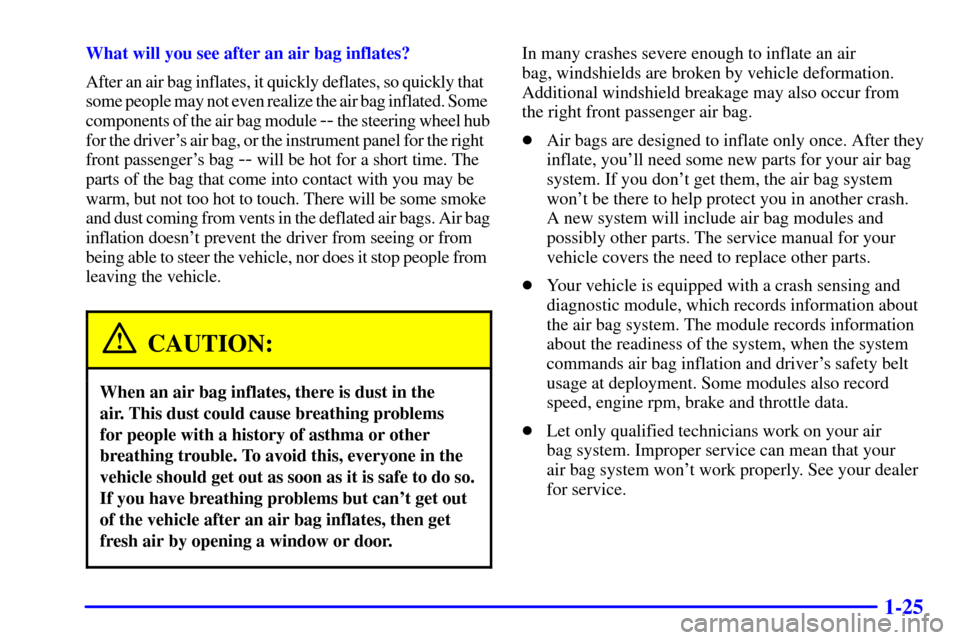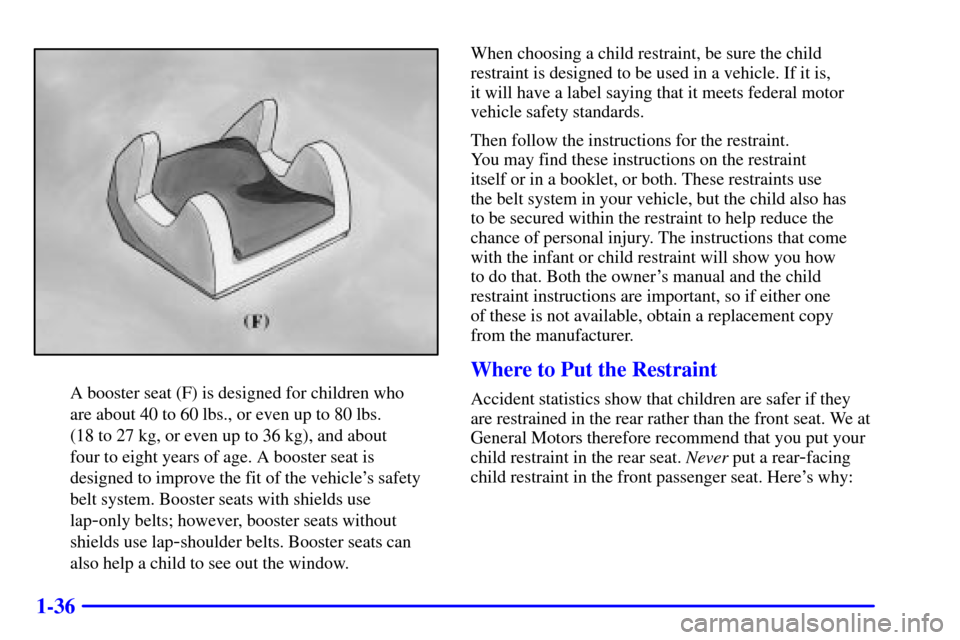Page 4 of 357
Table of Contents
Keys and Door Locks
Remote Keyless Entry (RKE) System
Hatch
Automatic Transmission (If Equipped)
Manual Transmission Operation (If Equipped)
Parking Brake
Windows
Tilt Wheel
Turn Signal/Multifunction LeverWindshield Wipers
Cruise Control
Interior and Exterior Lamps
Mirrors
Storage Compartments
Cargo Cover
Accessory Power Outlet
Instrument Panel, Warning Lights and Gages Seats and Seat Controls
Safety BeltsAir Bag System
Child Restraints
Section
1
Section
2
Seats and Restraint Systems
Features and Controls
ii
Page 11 of 357
ix
For example,
these symbols
are used on an
original battery:
CAUTION
POSSIBLE
INJURY
PROTECT
EYES BY
SHIELDING
CAUSTIC
BATTERY
ACID COULD
CAUSE
BURNS
AVOID
SPARKS OR
FLAMES
SPARK OR
FLAME
COULD
EXPLODE
BATTERY
These symbols
are important
for you and
your passengers
whenever your
vehicle is
driven:
DOOR LOCK
UNLOCK
FASTEN
SEAT
BELTS
POWER
WINDOW
AIR BAG
These symbols
have to do with
your lamps:
MASTER
LIGHTING
SWITCH
TURN
SIGNALS
PARKING
LAMPS
HAZARD
WARNING
FLASHER
DAYTIME
RUNNING
LAMPS
FOG LAMPS
These symbols
are on some of
your controls:
WINDSHIELD
WIPER
WINDSHIELD
WASHER
WINDSHIELD
DEFROSTER
REAR
WINDOW
DEFOGGER
VENTILATING
FAN
These symbols
are used on
warning and
indicator lights:
ENGINE
COOLANT
TEMP
BATTERY
CHARGING
SYSTEM
BRAKE
COOLANT
ENGINE OIL
PRESSURE
ANTI-LOCK
BRAKES
Here are some
other symbols
you may see:
FUSE
LIGHTER
HORN
SPEAKER
FUEL
Vehicle Symbols
These are some of the symbols you may find on your vehicle.
Page 37 of 357

1-25
What will you see after an air bag inflates?
After an air bag inflates, it quickly deflates, so quickly that
some people may not even realize the air bag inflated. Some
components of the air bag module
-- the steering wheel hub
for the driver's air bag, or the instrument panel for the right
front passenger's bag
-- will be hot for a short time. The
parts of the bag that come into contact with you may be
warm, but not too hot to touch. There will be some smoke
and dust coming from vents in the deflated air bags. Air bag
inflation doesn't prevent the driver from seeing or from
being able to steer the vehicle, nor does it stop people from
leaving the vehicle.
CAUTION:
When an air bag inflates, there is dust in the
air. This dust could cause breathing problems
for people with a history of asthma or other
breathing trouble. To avoid this, everyone in the
vehicle should get out as soon as it is safe to do so.
If you have breathing problems but can't get out
of the vehicle after an air bag inflates, then get
fresh air by opening a window or door.
In many crashes severe enough to inflate an air
bag, windshields are broken by vehicle deformation.
Additional windshield breakage may also occur from
the right front passenger air bag.
�Air bags are designed to inflate only once. After they
inflate, you'll need some new parts for your air bag
system. If you don't get them, the air bag system
won't be there to help protect you in another crash.
A new system will include air bag modules and
possibly other parts. The service manual for your
vehicle covers the need to replace other parts.
�Your vehicle is equipped with a crash sensing and
diagnostic module, which records information about
the air bag system. The module records information
about the readiness of the system, when the system
commands air bag inflation and driver's safety belt
usage at deployment. Some modules also record
speed, engine rpm, brake and throttle data.
�Let only qualified technicians work on your air
bag system. Improper service can mean that your
air bag system won't work properly. See your dealer
for service.
Page 48 of 357

1-36
A booster seat (F) is designed for children who
are about 40 to 60 lbs., or even up to 80 lbs.
(18 to 27 kg, or even up to 36 kg), and about
four to eight years of age. A booster seat is
designed to improve the fit of the vehicle's safety
belt system. Booster seats with shields use
lap
-only belts; however, booster seats without
shields use lap
-shoulder belts. Booster seats can
also help a child to see out the window.When choosing a child restraint, be sure the child
restraint is designed to be used in a vehicle. If it is,
it will have a label saying that it meets federal motor
vehicle safety standards.
Then follow the instructions for the restraint.
You may find these instructions on the restraint
itself or in a booklet, or both. These restraints use
the belt system in your vehicle, but the child also has
to be secured within the restraint to help reduce the
chance of personal injury. The instructions that come
with the infant or child restraint will show you how
to do that. Both the owner's manual and the child
restraint instructions are important, so if either one
of these is not available, obtain a replacement copy
from the manufacturer.
Where to Put the Restraint
Accident statistics show that children are safer if they
are restrained in the rear rather than the front seat. We at
General Motors therefore recommend that you put your
child restraint in the rear seat. Never put a rear
-facing
child restraint in the front passenger seat. Here's why:
Page 58 of 357

2-
2-1
Section 2 Features and Controls
Here you can learn about the many standard and optional features on your vehicle, and information on starting,
shifting and braking. Also explained are the instrument panel and the warning systems that tell you if everything is
working properly
-- and what to do if you have a problem.
2
-2 Keys
2
-4 Door Locks
2
-6 Keyless Entry System (If Equipped)
2
-11 Hatch
2
-13 Theft
2
-14 Content Theft-Deterrent/Alarm
System (Option)
2
-17 PASS-Key� II
2
-25 New Vehicle ªBreak-Inº
2
-25 Ignition Positions
2
-27 Starting Your Engine
2
-30 Engine Coolant Heater (Canada Only)
2
-32 Automatic Transmission Operation
2
-36 Manual Transmission Operation
2
-39 Parking Brake
2
-41 Shifting Into PARK (P)
(Automatic Transmission Only)
2
-42 Shifting Out of PARK (P)
(Automatic Transmission)2
-43 Parking Your Vehicle (Manual Transmission)
2
-43 Parking Over Things That Burn
2
-44 Engine Exhaust
2
-44 Running Your Engine While You're Parked
(Automatic Transmission)
2
-45 Limited-Slip Rear Axle
2
-45 Windows
2
-47 Tilt Wheel
2
-47 Turn Signal/Multifunction Lever
2
-52 Exterior Lamps
2
-55 Interior Lamps
2
-57 Mirrors
2
-58 Storage Compartments
2
-62 T-Top Roof Panels (Option)
2
-69 Convertible Top (If Equipped)
2
-76 The Instrument Panel -- Your
Information System
2
-80 Warning Lights, Gages and Indicators
Page 59 of 357
2-2
Keys
CAUTION:
Leaving children in a vehicle with the ignition
key is dangerous for many reasons. A child or
others could be badly injured or even killed.
They could operate the power windows or
other controls or even make the vehicle move.
Don't leave the keys in a vehicle with children.
Page 68 of 357

2-11 Resynchronization
Resynchronization may be necessary due to the security
method used by the remote keyless entry system.
The transmitter does not send the same signal twice
to the receiver. The receiver will not respond to a signal
that has been sent previously. This prevents anyone
from recording and playing back the signal from
the transmitter.
To resynchronize the transmitter with the receiver,
do the following:
1. Stand close to the vehicle.
2. Press and hold the LOCK and UNLOCK buttons
on the transmitter at the same time for about
eight seconds.
The door locks should cycle and the interior lamps
should flash to confirm resynchronization.
If this does not happen, you may need to replace the
battery in your transmitter or match the transmitter to
your vehicle. See ªMatching Transmitter(s) to Your
Vehicleº in the Index.
Hatch
CAUTION:
It can be dangerous to drive with the hatch open
because carbon monoxide (CO) gas can come
into your vehicle. You can't see or smell CO.
It can cause unconsciousness and even death.
If you must drive with the hatch open or if
electrical wiring or other cable connections
must pass through the seal between the body
and the hatch:
�Make sure all other windows are shut.
�Turn the fan on your heating or cooling
system to its highest speed with the setting
on VENT. That will force outside air into
your vehicle. See ªComfort Controlsº in
the Index.
�If you have air outlets on or under the
instrument panel, open them all the way.
See ªEngine Exhaustº in the Index.
Page 70 of 357

2-13
Theft
Vehicle theft is big business, especially in some cities.
Although your vehicle has a number of theft
-deterrent
features, we know that nothing we put on it can make it
impossible to steal. However, there are ways you can help.
Key in the Ignition
If you leave your vehicle with the keys inside, it's an
easy target for joy riders or professional thieves
-- so
don't do it.
When you park your vehicle and open the driver's door,
you'll hear a chime reminding you to remove your key
from the ignition and take it with you. Always do this.
Your steering wheel will be locked, and so will your
ignition. If you take the key with you, and you have an
automatic transmission, it will be locked. And remember
to lock the doors.
Parking at Night
Park in a lighted spot, close all windows and lock your
vehicle. Remember to keep your valuables out of sight.
Put them in a storage area, or take them with you.
Parking Lots
If you park in a lot where someone will be watching
your vehicle, it's best to lock it up and take your keys.
But what if you have to leave your ignition key?
�If possible, park in a busy, well lit area.
�Put your valuables in a storage area, like your
trunk or glove box. Be sure to close and lock the
storage area.
�Close all windows.
�Lock the glove box.
�Lock all the doors except the driver's.
�Then take the door key and remote keyless entry
transmitter with you.